Fish predators are living things that feed on fish. When such living things have access to your fish pond, they attack and eat or feed on the fish. Fish predators are very worrying to fish farmers because they cause a lot of fish lost to the farmers.
As a fish farmer, you need to be aware of such living things. In this article, we shall look at detailed information on the various types of fish predators, how each of them eat fish, and finally how to prevent them. So stay tuned to the end.
Types of Fish Predators
We have various types of living things that consume fish which we termed as fish predators. The outstanding ones include birds, mammals, reptiles, insects, and the fish themselves. Let’s look at each of them in detail.
Birds as Fish Predators
Birds are a common sight around fish ponds, but for fish pond owners, they can also be a source of concern and worry. Many bird species are natural predators of fish, and their presence can lead to significant losses if not managed properly.

Fish predatory bird
Types of Fish Predator Birds
The various types of birds that consume fish include;
Osprey (Pandion haliaetus) – Also known as the sea hawk, fish eagle, or fish hawk, it is a large bird of prey found around the world. I have found two hawks in two different occasions in my fish pond.
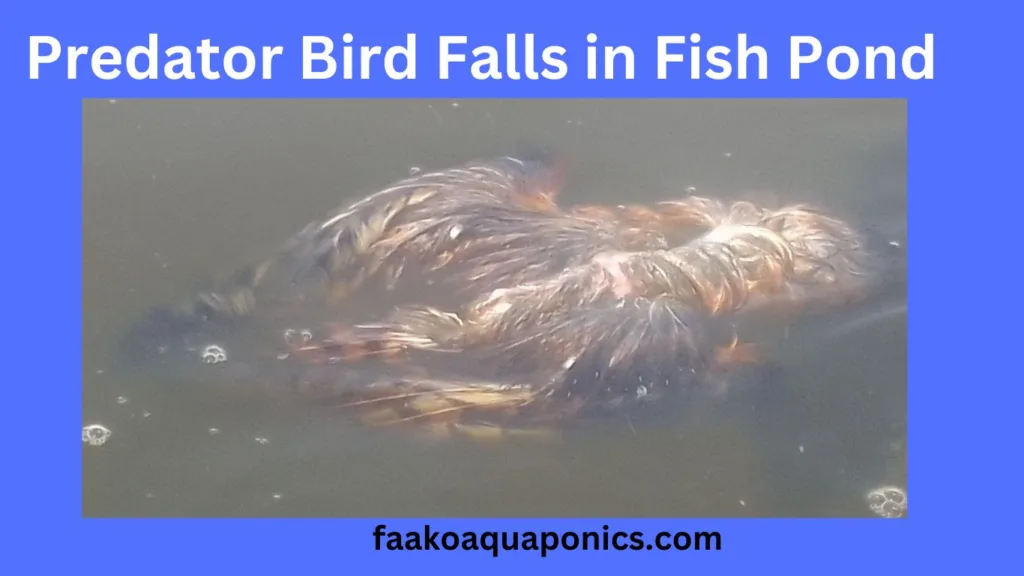
I found this hawk in my fish pond one day morning
Bald Eagle (Haliaeetus leucocephalus) – This iconic bird of North America is known for its distinctive white head and tail feathers and is commonly found near bodies of water where it feeds on fish.
Pied Kingfisher (Ceryle rudis) – Found in Africa and Asia, these birds are expert fishers, hovering over water before diving to catch their prey.
Common Kingfisher (Alcedo atthis) – Found in Europe, Asia, and North Africa, they are also known for their impressive fishing skills.
Great Blue Heron (Ardea herodias) – This large wading bird found in North America is often seen stalking shallow waters for fish.
Cormorants (Family: Phalacrocoracidae) – These aquatic birds are found worldwide, and many species are skilled divers and fishers.
Pelicans (Family: Pelecanidae) – Pelicans are large water birds found on all continents except Antarctica. They have a large throat pouch used for catching fish.
Gulls (Family: Laridae) – Many species of gulls, such as the Herring Gull and the Black-headed Gull, feed on fish, often scavenging along coastlines or stealing from other birds.
Terns (Family: Sternidae) – Terns are seabirds found worldwide, and many species dive into the water to catch fish.
Frigatebirds (Family: Fregatidae) – These tropical seabirds often snatch fish from the ocean’s surface or harass other birds until they drop their catch.
How Birds Prey on Fish
Birds have evolved various hunting strategies to catch fish from ponds, lakes, and streams. Here are some common methods they use:
1. Swooping: Birds like herons, kingfishers, and egrets are skilled at swooping down from the air to snatch fish near the water’s surface. Their sharp beaks and quick reflexes make them formidable hunters.
2. Wading: Some birds, such as herons and egrets, prefer to wade into shallow water to hunt. They slowly stalk their prey, waiting for the perfect moment to strike with lightning-fast precision.
3. Diving: Kingfishers are known for their diving prowess. They hover over the water, then dive headfirst to catch fish with their long, dagger-like bills.
Prevention Methods of Fish Predators
Now that we understand how birds hunt fish, let’s explore some effective prevention methods to keep fish predators who are birds away;
1. Bird Netting: Installing bird netting over your pond is one of the most effective ways to prevent fish predation. Choose a fine mesh netting that birds cannot penetrate, and ensure it is securely fastened to prevent any gaps.
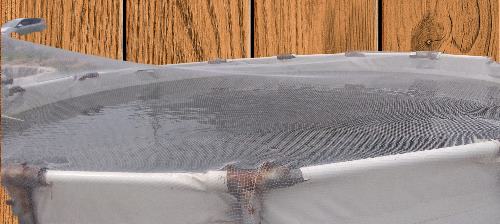
Tarpaulin fish pond covered with net to prevent fish predators
2. Decoys and Scare Tactics: Place decoys of predators like herons or owls near the pond to deter real birds. You can also use reflective objects, like CDs or wind chimes, to create movement and scare off potential predators.
3. Habitat Modification: Alter the pond’s surroundings to make it less attractive to birds. Trim overhanging branches and vegetation to remove potential perches for birds, and consider adding tall grasses or shrubs around the pond’s perimeter to provide cover for fish.
4. Fish Shelters: Introduce fish shelters or hiding places in your fish pond, such as floating plants, rocks, or submerged structures. These features provide a refuge for fish to escape from bird predators.
5. Scarecrow or Pets: A scarecrow positioned near the pond or a vigilant pet like a dog can deter birds from approaching. The presence of a perceived threat may keep birds at a distance.
6. Supplementary Feeding: Providing an alternative food source, such as bird feeders placed away from the pond, may help divert bird attention away from your fish.
7. Regular Monitoring: Keep a close eye on your pond and observe bird activity. Early detection of bird predation allows for prompt intervention to prevent further losses.
Mammals as Fish Predators
Mammals can be pesky predators when it comes to your fish pond. Raccoons, otters, and minks are just a few of the furry culprits that may be eyeing up your aquatic residents as a tasty snack.
Types of Mammals Fish Predators
1. Raccoons: Raccoons are notorious for their intelligence and dexterity. They have nimble paws that allow them to wade into the water and snatch fish. Raccoons are also known to overturn containers or dig into pond banks to reach their prey.
2. Otters: Otters are proficient swimmers and can hunt both underwater and from the shore. They have sharp teeth and strong jaws that allow them to catch and consume fish with ease.
3. Minks: Minks are agile hunters, able to swim and climb with ease. They have sharp claws and teeth that they use to catch and kill fish in shallow waters.
Prevention Methods of Mammals Fish Predators
– Fencing: Erect a sturdy fence around your pond with a height of at least 3 feet. Bury the fence at least 6 inches below ground to prevent raccoons from digging underneath.
– Motion-Activated Devices: Install motion-activated sprinklers or lights near the pond to startle raccoons and discourage them from returning.
– Natural Barriers: Create a barrier around the pond using rocks or plants to discourage otters from entering. Otters prefer easy access to water, so making it more difficult for them to approach can help protect your fish.
– Fencing: Similar to raccoons, fencing can be effective in deterring otters. Make sure the fence is tall enough and extends below ground level.
– Cover and Shelter: Provide hiding places for your fish by incorporating rocks, plants, and structures into your pond. This makes it harder for minks to spot and catch their prey.
– Netting: Cover your pond with fine mesh netting to prevent minks from accessing the fish. Ensure the netting is securely fastened to avoid any gaps.
Reptiles as Fish Predators
Reptiles, with their stealthy hunting tactics, pose a significant threat to fish in ponds as fish predators. Various types of reptiles predate fish. Some of them are;
1. Snakes: Various snake species, including water snakes, garter snakes, and even some non-venomous snakes like rat snakes prey on fish.
Snakes are proficient swimmers and can easily enter ponds to hunt for fish as fish predators. They use stealth and patience to ambush their prey, often waiting motionless near the water’s edge or hiding among vegetation until an opportunity arises.
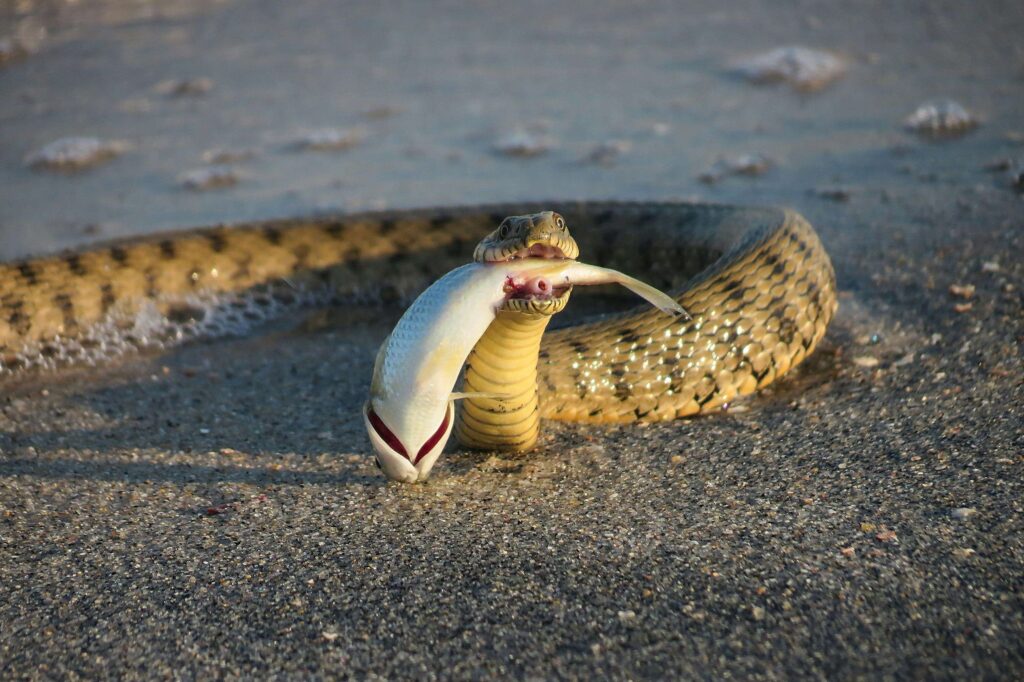
Snake as fish predator
2. Turtles: Common pond turtles, such as red-eared sliders, painted turtles, and snapping turtles, are known to prey on fish.
Turtles are opportunistic feeders and will consume fish when given the chance. They use their sharp beaks to grab onto prey and can remain submerged for extended periods, waiting for an unsuspecting fish to swim by.
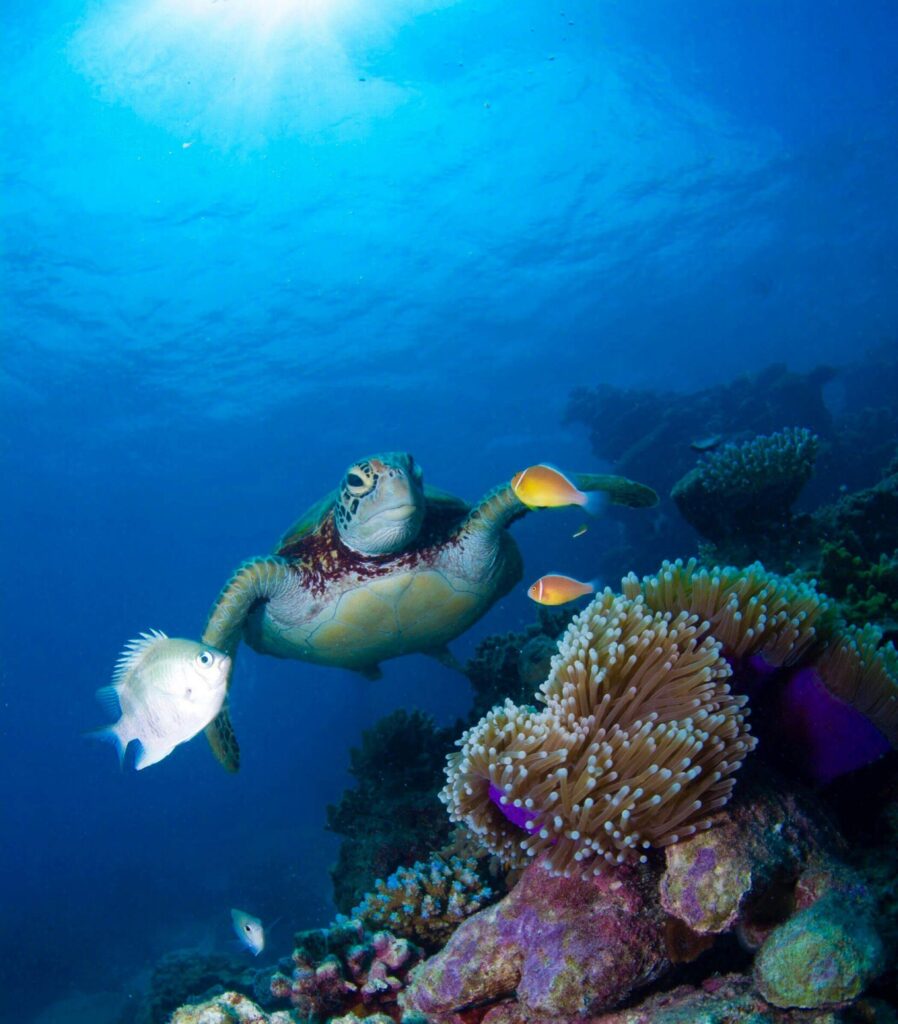
Turtles as fish predator
Effective Prevention Methods of Reptiles as Fish Predators
1. Habitat Modification: Keep the pond area tidy and free of debris to discourage reptiles from lurking around. Regular maintenance reduces hiding spots and makes the environment less attractive to predators.
2. Barriers: Use physical barriers like rocks, wire mesh, or fencing to prevent reptiles from accessing the pond. Ensure that barriers are securely installed and have no gaps where predators could squeeze through.
3. Floating Plants: Introduce floating vegetation to provide cover for fish and make it harder for reptiles to spot and capture them. Additionally, plants help improve water quality and provide a natural aesthetic to the pond.
4. Predator-Free Zones: Create areas in the pond where fish can retreat and hide from predators. Incorporate structures like caves, rocks, or dense vegetation to provide refuge for fish when threatened.
5. Regular Monitoring: Keep an eye on your pond and watch for signs of reptile activity, such as tracks or droppings. Early detection allows for prompt action to prevent fish predators from predation.
Insects as Fish Predators
Fish ponds are often seen as peaceful havens, but lurking beneath the surface are some surprising predators – insects. These tiny creatures can wreak havoc on your fish population if left unchecked.
Types of Insect Fish Predators
1. Dragonfly Larvae: Dragonfly larvae are aquatic nymphs that live underwater, preying on small fish and other aquatic organisms. They use their extendable jaws to grasp and consume prey, including fish fry and smaller fish.
2. Water Bugs (Belostomatidae): Water bugs, also known as giant water bugs or toe-biters, are large aquatic insects with piercing mouthparts.
They ambush prey from below, injecting enzymes into their victims and sucking out the liquefied contents. Fish are among their favorite targets as fish predators.
3. Backswimmers (Notonectidae): Backswimmers are small, streamlined insects that swim upside-down at the water’s surface. They are agile hunters, using their sharp mouthparts to pierce and feed on fish and other small aquatic organisms..
Prevention Methods of Insects as Fish Predators
1. Biological Control: Introduce natural predators of insect larvae, such as certain species of fish or aquatic insects like damselflies, to help keep their populations in check.
2. Remove Vegetation: Regularly trim and remove overhanging vegetation around the pond. This reduces hiding places for insects and makes it easier for fish to detect and evade predators.
3. Use Physical Barriers: Install fine mesh netting over the pond to prevent adult insects from laying eggs in the water. Ensure the netting is securely fastened to avoid any gaps.
4. Provide Shelter: Add floating plants, submerged vegetation, and other structures to the pond to provide hiding places for fish. These features also create a complex environment that can confuse and deter insect fish predators.
5. Maintain Water Quality: Proper filtration, aeration, and regular water changes help maintain optimal water quality, which can deter insect breeding and promote the health of your fish.
6. Monitor and Act Promptly: Regularly inspect your pond for signs of insect infestation, such as unusual behavior in fish or an increase in insect activity. Take immediate action to address any issues before they escalate.
Cannibalism
The final type of fish predator I will talk about is cannibalism. Cannibalism is when a fish species attacks and consumes another fish species. It could be in the same species or across species.
This can be done for several reasons including, overcrowding, poor nutritional provision, poor water quality, and others.
Check out a full blog post on Cannibalism.
Advantages of Fish Predation in Fish Farming
Fish predation, while often viewed negatively in the context of fish ponds, actually plays a crucial role in maintaining the balance and health of aquatic ecosystems. In this blog post, we’ll explore the advantages of fish predation and how it contributes to the overall functioning of aquatic environments.
1. Controlling Prey Populations
Fish predators help control the populations of their prey species, preventing them from becoming overabundant. By consuming smaller organisms like insects, crustaceans, and smaller fish, fish predators help maintain a balance within the ecosystem. This prevents the unchecked growth of prey populations, which can lead to competition for resources and habitat degradation.
2. Maintaining Biodiversity
Fish predation can promote biodiversity by creating niches for a variety of species within an ecosystem. Fish Predators often target specific prey, which can lead to the coexistence of multiple species with different adaptations and behaviors. This diversity contributes to the resilience of the ecosystem and its ability to withstand environmental changes.
3. Nutrient Cycling
When fish consume prey, they assimilate nutrients from their food, which are then released back into the ecosystem through excretion. This process helps recycle nutrients, such as nitrogen and phosphorus, back into the water, where they can be utilized by aquatic plants and other organisms. In turn, this promotes the growth of algae and plankton, which form the base of the aquatic food web.
4. Enhancing Water Quality
Fish predators can indirectly improve water quality by controlling the abundance of algae and other primary producers. Excessive algal growth can lead to oxygen depletion and water turbidity, which can harm aquatic life.
By consuming algae-eating organisms like zooplankton and small invertebrates, predator fish help maintain a healthy balance of nutrients and prevent algal blooms.
Disadvantages of Fish Predation in Fish Ponds
While fish predation is a natural part of aquatic ecosystems, it can present challenges for fish farmers managing ponds.
1. Loss of Stock
One of the most significant disadvantages of fish predation in fish ponds is the loss of valuable stock. Predatory birds, mammals, reptiles, and insects can prey on fish, leading to reduced yields and financial losses for fish farmers. This can be particularly problematic for species that are vulnerable to predation, such as young fry or smaller fish.
2. Reduced Growth Rates
Fish that are constantly under threat from predators may experience stress, which can hinder their growth and development. Fear of predation can lead to decreased feeding activity and lower energy reserves, resulting in slower growth rates.
This can prolong the time it takes for fish to reach market size, impacting the profitability of fish farming operations.
3. Increased Stress and Disease Risk
Constant harassment from fish predators can cause chronic stress in fish, making them more susceptible to diseases and infections. Stress weakens the immune system, leaving fish vulnerable to pathogens and parasites that can spread rapidly in crowded pond environments. Disease outbreaks can devastate fish populations and require costly interventions to control.
4. Disruption of Breeding and Spawning
Fish Predators can disrupt the breeding and spawning activities of fish, affecting reproductive success and population dynamics. Fish may avoid spawning areas or alter their behavior to avoid predation, leading to decreased reproductive output. This can have long-term implications for maintaining healthy fish populations and genetic diversity within the pond.
5. Increased Management Efforts and Costs
Managing predation in fish ponds requires additional time, effort, and resources from fish farmers. Installing deterrents such as netting, fencing, or scare devices can be labor-intensive and costly. Continuous monitoring of predator activity and implementing control measures may also add to the operational expenses of fish farming.
6. Environmental Impact
Some fish predator control methods, such as chemical pesticides or mechanical traps, can have unintended environmental consequences. Chemicals may leach into the water, affecting non-target species and water quality. Mechanical traps may harm other wildlife or disrupt the natural balance of the ecosystem.
Conclusion
Maintaining a fish pond requires careful consideration of potential threats from fish predators. By understanding the behaviors of common pond fish predators, and implementing effective prevention methods, you can create a safe and thriving aquatic ecosystem.
From bird netting to natural barriers, there are numerous strategies available to protect your fish and enjoy the security of your fish pond.

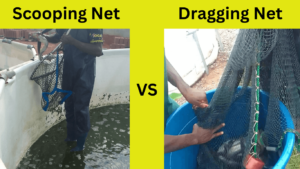


Saved as a favorite, I love your site!
This is the right site for anybody who wants to find out about this topic. You understand so much its almost tough to argue with you (not that I actually would want to…HaHa). You definitely put a new spin on a topic that has been written about for many years. Excellent stuff, just wonderful.
Hello there! I could have sworn I’ve been to this site before but after browsing through many of the articles I realized it’s new to me. Regardless, I’m certainly pleased I came across it and I’ll be book-marking it and checking back frequently!
Thanks for sharing. I read many of your blog posts, cool, your blog is very good.
Can I simply say what a relief to uncover a person that actually understands what they are talking about on the internet. You actually understand how to bring an issue to light and make it important. A lot more people really need to read this and understand this side of your story. It’s surprising you are not more popular given that you definitely possess the gift.
This site was… how do you say it? Relevant!! Finally I have found something that helped me. Thanks.
There’s definately a lot to learn about this issue. I like all of the points you’ve made.
Aw, this was a really nice post. Spending some time and actual effort to produce a great article… but what can I say… I put things off a lot and don’t manage to get anything done.
I really love your blog.. Excellent colors & theme. Did you create this website yourself? Please reply back as I’m looking to create my own personal website and would love to know where you got this from or what the theme is called. Thank you.
Enjoyed every bit of your blogReally thank you! Keep writing
It’s not my first time to visit this web page, i am visiting this website dailly and
take nice information from here all the time.
Very interesting information!Perfect just what
I was searching for!!
Great info and straight to the point. I am not sure
if this is in fact the best place to ask but do you guys
have any thoughts on where to employ some professional writers?
Thanks 🙂 Lista escape room
[…] Predator Concerns: Koi are susceptible to predation by birds, raccoons, and other wildlife. Protective measures, such as netting, may be […]
папа таро значение ленорман сонник большие черепахи в воде гадание на рунах на вопрос к чему снится что все забыли про мой день рождения сонник разговор с монахиней, монахиня символ
Hello there! Thiss blog post couldn’t bee written much
better! Going through this article reminds me of my previous roommate!
He always kept talking about this. I will forward this article to him.
Fairly certain he’s going to have a good read. Many thanks for sharing! https://www.waste-NDC.Pro/community/profile/tressa79906983/